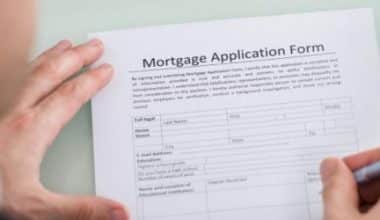There’s one thing about loans that keeps attracting people to it, it always comes in handy. Of course, from a mortgage loan to an auto loan, so long as you have a good credit score, and what it takes to repay the debt, lenders will willing to lend you money. And if what you seek is a loan for building a house, you’ll get that too. A loan for building a house is a type of loan that is specifically designed to finance the construction of a new home. This type of loan is different from a traditional mortgage loan, which is typically used to purchase an existing home. These loans are typically dispersed in stages as the construction process progresses. This is known as a construction loan.
The lender will disburse funds as each stage of the construction process is completed, rather than providing a lump sum upfront. The amount of the loan is typically based on the estimated cost of construction. Generally, it includes the cost of materials, labor, and any necessary permits. The lender may also take into account the value of the land that the home will be built. A loan for building a house can be a good option if you are looking to build a new home. However, it’s important to carefully consider the costs and the terms of the loan before applying. You should also work with a reputable lender who has experience in construction loans.
It’s important to note that construction loans often have higher interest rates and shorter terms than traditional mortgage loans. They are considered riskier for lenders, as there is a greater chance that the project may not be completed on time or on budget.
How Does a Loan for Building a House Work?
Generally, the process of getting a loan to build a house can be a bit complex. It may require additional documentation and inspections throughout the construction process. Working with a lender who has experience in construction loans can make the process easier and ensure that your project stays on track.
Generally, this is how it works:
#1. You Apply for a Construction Loan
You’ll need to find a lender who offers construction loans and apply for the loan. The lender will evaluate your creditworthiness and your ability to repay the loan.
#2. Get Approval
If the lender approves your loan application, they will set the loan terms and disbursement schedule. They will also determine how much money they will lend you.
#3. Money Disbursement Stages
Unlike a traditional mortgage loan, where you receive the entire loan amount upfront, a construction loan is typically disbursed in stages as the construction process progresses. These stages are often called “draws.” Each draw is released when a specific phase of construction is completed. The lender will also verify the work before releasing the funds.
#4. Pay Interest on the Amount Disbursed
As the loan is disbursed in stages, you will only be required to pay interest on the amount that has been disbursed so far.
#5. Loan Conversion to a Mortgage
Once the construction of your home is complete, the construction loan will need to be converted to a mortgage loan. This is called the “end loan” or “take-out loan.” The lender will require an appraisal of the completed home and base the mortgage loan amount on the appraised value.
#6. Begin Monthly Mortgage Payments
Once the loan is converted to a mortgage loan, you will begin making regular monthly payments that include both principal and interest.
How to Get a Loan for Building a House
If you want to get a construction loan and do not know how to go about it, relax, we’ve got you covered. The following is a step-by-step guide on how to get your building loian:
#1. Determine Your Budget
Before you start looking for a lender, it’s important to determine your budget for building your new home. This includes figuring out the total cost of the project, including land, materials, labor, and any other associated costs.
#2. Find a Lender
Once you have determined your budget, you can start looking for a lender who offers construction loans. You can search online, ask for recommendations from friends and family, or check with your local bank or credit union.
#3. Gather Your Documents
Before applying for a loan, you will need to gather your financial documents. These documents include tax returns, pay stubs, bank statements, and any other documents that show your income and assets.
#4. Apply for the Loan
You will need to complete a loan application and submit it to the lender. The lender will evaluate your creditworthiness, income, and assets to determine if you qualify for the loan.
#5. Provide Project Details
The lender will also need information about the construction project, including the plans, permits, and cost estimates. The lender may also require an appraisal of the land and plans to ensure that the project is viable.
#6. Get Loan Approval
If your loan application is approved, the lender will provide you with a loan agreement document. This outlines the terms and conditions of the loan, including the loan amount, interest rate, and repayment period.
#7. Disbursement of Funds
Once the loan is approved, the lender will disburse funds to the builder in stages as the construction progresses. This is typically done through a series of draws, where the builder submits invoices and receipts for completed work, and the lender releases funds to cover those costs.
#8. Conversion to a Mortgage Loan
Once the construction of your home is complete, the construction loan will need to be converted to a mortgage loan. The lender will require an appraisal of the completed home and will base the mortgage loan amount on the appraised value.
#9. Begin Making Mortgage Payments
Once the loan is converted to a mortgage loan, you will begin making regular monthly payments that include both principal and interest.
How To Get a Loan for Building a House
Remember, finding the right loan for building a house is a process that requires careful research and consideration. By taking the time to compare options and find a lender who has experience in construction loans, you can help ensure that your project is successful and on budget.
The following is a detailed guide on how to find the best loan for building a house:
#1. Determine Your Budget
Before you start looking for a loan, it’s important to determine your budget for building your new home. This includes figuring out the total cost of the project, including land, materials, labor, and any other associated costs.
#2. Research Your Options
Once you have determined your budget, you can start researching your options for construction loans. Some lenders specialize in construction loans, while others offer a variety of mortgage options, including construction loans. You can search online, ask for recommendations from friends and family, or check with your local bank or credit union.
#3. Compare Interest Rates and Fees
When comparing loans, it’s important to consider both the interest rate and any associated fees. Construction loans typically have higher interest rates than traditional mortgage loans, but the fees can vary widely between lenders. Make sure to compare both the interest rate and any fees, such as application fees, origination fees, or inspection fees.
#4. Look for Flexible Terms
Construction projects can be complex and unpredictable, so it’s important to find a loan that offers flexible terms. This may include the ability to extend the loan term if construction is delayed, or the ability to change the loan amount if the project costs more than anticipated.
#5. Check for Prepayment Penalties
Some construction loans may have prepayment penalties. This simply means you will be charged a fee if you pay off the loan early. Make sure to check for prepayment penalties and factor that into your decision-making process.
#6. Consider Lender Experience
Building a home is a complex process, therefore working with a lender who has experience in construction loans is best. Look for lenders who have a track record of successfully funding construction projects and who can provide guidance and support throughout the process.
#7. Get Pre-approved
Once you have found a lender that you are interested in working with, you can apply for pre-approval. This will give you an idea of how much you can borrow and what your interest rate and fees will be.
#8. Apply for the Loan
Once you have found the right loan for your needs, you can apply for the loan. Make sure to have all of your financial documents in order and be prepared to provide details about the construction project, including plans, permits, and cost estimates.
#9. Work with Your Lender Throughout the Process
Building a home is a complex process, and it’s important to work closely with your lender throughout the process. They can provide guidance and support, and help ensure that your project stays on track.
Best Loan for Building a House
The best loan for building a house will depend on your individual financial situation and the specific details of your construction project. However, here are some common types of loans that are often used for building a house:
#1. Construction-to-permanent Loans
This type of loan combines the construction loan and the mortgage into one loan, which can be convenient and save you money on closing costs. During the construction phase, you will make interest-only payments on the loan, and then once construction is complete, the loan will convert to a traditional mortgage.
#2. Stand-alone Construction Loans
This type of loan is designed specifically for construction projects and typically has higher interest rates and fees than traditional mortgages. With a stand-alone construction loan, you will make interest-only payments during the construction phase, and then pay off the loan in full once construction is complete.
#3. FHA 203(k) Loans
This type of loan can be used to purchase an existing property and finance the cost of renovations, including major structural repairs and building additions. This loan may be a good option if you are purchasing an older home and need to make significant repairs or upgrades.
#4. VA Construction Loans
This type of loan is designed specifically for military veterans and can be used to build a new home or make improvements to an existing home. The loan typically offers favorable terms, including no down payment and no private mortgage insurance (PMI).
#5. Home Equity Loans or Lines of Credit
If you already own a home and have built up equity, you may be able to use a home equity loan or line of credit to finance your construction project. These loans typically have lower interest rates than construction loans but may require you to use your existing home as collateral.
Can I Get Loan to Build a House in the USA?
Yes, you can get a loan to build a house in the USA. Construction loans are a type of loan that is specifically designed to help you finance the construction of a new home. These loans typically have higher interest rates and fees than traditional mortgages, but they offer a flexible draw schedule that allows you to access funds as needed throughout the construction process.
To qualify for a construction loan, you will typically need to have a good credit score, a solid financial history, and a detailed plan for the construction project. This will include detailed plans and specifications for the home, as well as cost estimates for materials and labor.
To apply for a construction loan, you will need to work with a lender who offers these types of loans. This can be a bank, credit union, or specialized mortgage lender. You will need to provide detailed information about your financial situation and the construction project, and the lender will review your application and determine whether you qualify for the loan.
What Kind of Loan Do I Need to Build?
To build a new home, you will generally need a construction loan. A construction loan is a type of short-term loan that is specifically designed to finance the construction of a new home. These loans typically have higher interest rates and fees than traditional mortgages, but they offer a flexible draw schedule that allows you to access funds as needed throughout the construction process.
How to Build a House With Little Money in the USA?
Building a house with little money in the USA can be challenging, but it is possible if you are willing to be resourceful and creative. Here are some tips to help you build a house on a budget:
- Find an affordable location: One of the biggest expenses when building a house is the cost of land. Look for areas with lower land prices or consider purchasing a smaller lot.
- Use recycled or salvaged materials: You can save money by using recycled or salvaged materials for your building project. For example, reclaimed lumber salvaged windows and doors, and recycled roofing materials can be found at lower costs than new materials.
- Consider a simple design: The more complex the design, the more expensive it will be to build. Consider a simple, straightforward design that can be built quickly and efficiently.
- Do some of the work yourself: You can save money on labor costs by doing some of the work yourself. For example, you can paint, lay flooring, and even install cabinets.
- Look for alternative financing options: Traditional bank loans may not be an option if you have little money. Look for alternative financing options, such as owner financing or a personal loan.
- Plan ahead: Planning ahead can help you avoid costly mistakes and oversights. Create a detailed budget and stick to it, and work closely with a builder or architect to ensure that you are getting the most out of your budget.
How Much is Block for Building House in the USA?
The cost of a building block in the USA can vary widely depending on several factors such as the location, size, quality, and availability of the block. Additionally, there are different types of blocks used for building houses such as concrete blocks, cinder blocks, and clay bricks, which also have different costs.
As of my knowledge cutoff date of September 2021, the average cost of a concrete block in the USA ranged from $1.50 to $3.50 per block, while a cinder block could cost between $1 and $3 per block. The cost of clay bricks can be even higher, typically ranging from $0.50 to $1.50 per brick.
How Much Will it Cost to Build a 6-bedroom House in the USA?
The cost of building a 6-bedroom house in the USA can vary widely depending on several factors such as the location, size, materials used, labor costs, and other variables. Without knowing specific details about the project, it is difficult to provide an accurate estimate of the cost.
However, to provide a rough estimate, according to HomeAdvisor, the average cost to build a house in the USA is approximately $150 to $200 per square foot. This means that for a 6-bedroom house with an average size of 3,000 square feet, the total cost could range from $450,000 to $600,000.
Can 5 Million Build a House in the USA?
Yes, it is certainly possible to build a house in the USA with a budget of 5 million dollars. However, the actual cost of building a house will depend on various factors, such as the location of the property, the size and style of the house, the type of materials used, the complexity of the design, and the cost of labor.
Is it Cheaper to Build or Buy a House in the USA?
Whether it is cheaper to build or buy a house in the USA depends on several factors, such as the location, size, materials used, labor costs, and other variables. Generally speaking, building a house can be more expensive upfront, but it can also allow you to get the exact features and finishes you want in a home.
On the other hand, buying a house can be more affordable in some cases, especially if you are able to find a house that fits your needs and budget. However, you may have to compromise on some features and finishes if you buy an existing home.
When you buy a house, you will also need to factor in additional costs such as closing costs, real estate agent fees, and potential repairs or renovations.
How Does Debt Consolidation Work?
Debt consolidation is a financial strategy that involves combining multiple debts into a single, more manageable payment. Here’s how it works:
- Assess your debts: First, you’ll need to take stock of all your debts, including credit cards, loans, and other types of debt.
- Determine your consolidation method: Next, you’ll need to decide how you want to consolidate your debts. Some common methods include taking out a personal loan, opening a balance transfer credit card, or using a home equity loan or line of credit.
- Apply for a consolidation loan: If you decide to go with a personal loan or home equity loan, you’ll need to apply and be approved for the loan. The lender will review your credit history and other financial factors to determine your eligibility and interest rate.
- Use the loan to pay off your debts: Once you receive the loan funds, you can use the money to pay off your existing debts. This will leave you with a single loan payment to make each month.
- Make payments on time: It’s important to make your consolidation loan payments on time to avoid late fees and a negative impact on your credit score.
- Construction Project: Meaning, Examples & Best Software
- PROJECT MANAGER QUALIFICATIONS: What You Should Know, Steps to Follow, and Salary
- HOW TO GET INTO PROJECT MANAGEMENT: Definition, Guide, and Requirement
- HOME BUILDING LOAN: How It Works & How to Get It
- Construction Project Management: Beginner’s Guide to Efficient Management






